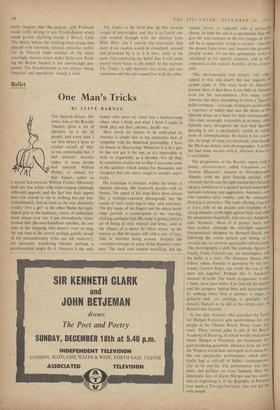Ballet
One Man's Tricks
By cLIVE BARNES
THE Spanish dancer, An- tonio, now at the Royalty Theatre, gives a lot of pleasure toe a lot of people, and every time 1 see him dance I have to remind myself of that, to me, remarkable fact. 1 \feel towards Antonio rather as some people feel towards Wilfred Pickles, or indeed, for that matter, rather as I myself feel towards Wilfred Pickles. Obviously both are fine artists with Wide-ranging (although different) appeals, and the fact that their appeal does not extend to me is nothing but .my loss. Unfortunately just as soon as the one chummily croaks "Ave. a go!' or the other flashes his tight- lipped grin at the audience, waves of embarrass- ment sweep over me. I am immediately trans- formed into the over-fastidious outsider, the one man in the singsong who doesn't want to sing, the one man iii the crowd, perhaps guiltily proud of his nonconformity (who can tell motives?), yet nervously wondering whether perhaps a' psychoanalyst might fix it. Antonio is the only dancer who turns my mind into a battleground, where what I think and what 1 think I ought to think play out their chronic, deadly war.
How much my failure to be enthralled by Antonio is simply due to my instinctive. lack of sympathy with his theatrical personality, I have no means of discovering. Whatever it is he's got, he has not got it for me, so it's impossible to write as impartially as a devotee. For all that. he sometimes excites me so that 1 can sense some of the qualities which subdue his thousands, and recognise that one man's magic is another man's tricks.
His technique is limitless, within the limits of Spanish dancing. His footwork dazzles with its finesse. The speed of his steps blurs them almost like a multiple-exposure photograph, but the sound of their ticker-tap is clear and articulate. The dry snaps of his fingers and his sharp hand- claps provide a counterpoint to the weaving, clicking,southpaw feet. His body is given a boxer's air of being at once relaxed and tense, until at the climax of a dance he often screws up the tension so that he seems stiff with a sort of. fury. This is Antonio being serious. Antonio the comedian emerges in some of his flamenco num- bers. The dark eyes remain unsmiling, but the intense frown is replaced with a grimacing charm. In both the aim is a spontaneity that will give life and credence to the two images of him- self he is apparently trying to project—Antonle the demon Latin lover, and Antonio the adorahh' playful urchin. To me this spontaneity looks calculated as his spot-lit entrance, and as WI conscious as the ecstatic humility of his cort:til, calls.
This showmanship and artistry will cithv appeal or not, and clearly the vast majority H people enjoy it. The main fault of Antonio • present show is that there is too little of Antonio even for his non-admirers. For many year' Antonio has been attempting to form a 'Spanish ballet company'—a troupe of dancers performing a repertory of ballets that take the idiom of the Spanish dance as a basis for their choreographh• This idea, seemingly irresistible to so many other Spanish stars, disregards the fact that Spanish dancing is not a particularly varied or telliag form of communication. Its mood is too relent- less, its-range of steps too restricted, even though the Mexican dancer and choreographer. Luisillo. has had some success with it. Antonio, howocr. is no Luisillo.
The programme at the Royalty opens \■ lilt 3 dreary divertissement called Variations On a Spanish Rhapsody, danced to ill-orchestrated Albeniz, with the girls floating around with coloured shawls and the tight-panted boys holding LIP grey sombreros in a gesture poised somewhere between welcome and aggression. Antonio's oval solo numbers have vitality, and the company s final joia is attractive. The main offering, Jugandd al Toro, tells of the dreams and, triumphs of 3 young matador in His fight against bulls and what the programme hopefully, but not very helpfully. calls 'Symbols.' Most of it proves more bull than symbol, although the bull-fight sequence (imaginatively designed by Bernard Daydd and following the actual pattern and timing of 3 eOrrida) has an obvious spectacular effectiveness. The choreography is dull, the symbolic figures of Vanity, Fame, Fortune, etc., are meaningless. and the ballet is a bore. The flamenco dances that follow, where Antonio is partnered by the fi.re- brand, Carmen Rojas. are worth the rest of the show put together. Perhaps this is Antonio 5 moment of truth. The whole programme I think, have been better if he had left his ballets would.
and his company behind him, and accompanied by nothing more than a partner, a singer. 3 guitarist and, . yes, perhaps, a spotlight, just danced. Danced as he did in the simple days of Rosario and Antonio.
It was also Antonio who provided the finale for Margot Fonteyn's gala performance for toP people at the Theatre Royal, Drury Lane, last week. These annual galas in aid of the Royal Academy of Dancing, of which worthy institution Dame Margot is President, are beanfeasts for gourmandising gourmets. Dancers from all over the Western world had converged on London for this one spectacular performance, which prac- tically had a roll-call of ballet's contemporary elite as its cast-list. The performance was fan- tastic, but perhaps no more fantastic than the diplomatic feat of Dame Margot and her assist- ants in organising it. If the Republic of Panama ever needs a Foreign Secretary who can get 011 with people . . .


































 Previous page
Previous page